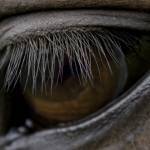Equine Cushing’s Disease and Eye Health

Uncontrolled Cushing’s disease (pituitary pars intermedia dysfunction, PPID) negatively impacts the health and quality of life of horses in multiple ways. Increased levels of the stress hormone cortisol caused by a growth in the pars intermedia region of the pituitary wreaks havoc on almost every organ system. Classic signs of disease include a poor coat, recurrent laminitis, lethargy, abnormal fat deposits, and increased thirst and urination. Moreover, the effects of Cushing’s may extend to the eyes.
Steroids, including corticosteroids used to treat simple eye conditions such as conjunctivitis, are contraindicated for other ocular conditions, such as corneal ulcers and certain infections. Corticosteroids, including cortisol, inhibit wound healing. Clearly, a veterinarian would not prescribe such medications to any horse with an ocular wound, but what about the natural cortisol levels found in the tears? Could the cortisol in tears slow or completely impede healing of eye injuries?
According to a recent study*, cortisol concentrations in the tears of horses and ponies diagnosed with PPID were significantly higher than in age-matched controls, mirroring an increase in blood cortisol levels. Further, treatment with pergolide did not appear to decrease tear cortisol levels in affected horses and ponies. The exact cause of the increased tear cortisol concentrations remains unclear, and the authors noted the preliminary nature of this study. Nonetheless, the results serve to propound possible complications associated with treating ocular diseases in horses and ponies with PPID.
“Ways to prevent the development of PPID remain conservative at best, leaving owners reliant on treatment. Even though pergolide mesylate is available in an equine formulation and reportedly serves as an effective treatment for horses and ponies diagnosed with PPID, don’t forget about the importance of diet in managing equine Cushing’s disease,” advised Kathleen Crandell, Ph.D., an equine nutritionist for Kentucky Equine Research (KER).
Key dietary factors when managing horses and ponies with PPID include:
- Achieving and maintaining an ideal body weight;
- Eliminating high-starch feeds, including traditional sweet feeds;
- Replacing concentrates with a vitamin and mineral supplement, such as Micro-Max (Gold Pellet in Australia) for overweight horses, or a low-starch feed for horses that have trouble maintaining weight;
- Offering a hindgut buffer to help minimize laminitic flare-ups; and
- Supplementing with a product such as Bio•Bloom PS (Bio-Bloom HF in Australia) to support hoof health.
*Hart, K.A., K.M. Kitchings, S. Kimura, et al. 2016. Measurement of cortisol concentration in the tears of horses and ponies with pituitary pars intermedia dysfunction. American Journal of Veterinary Research. 77(11):1236-1244.








